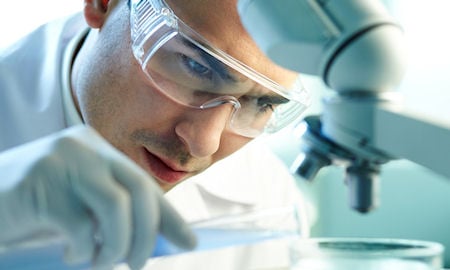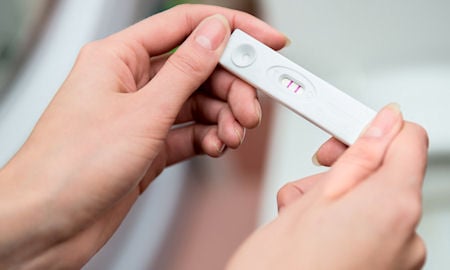
Glossary
American Society for Reproductive Medicine (ASRM). A professional medical organization of more than 8,000 health care professionals dedicated to reproductive medicine.
Amniocentesis. A procedure in which a small amount of amniotic fluid is removed through a needle from the fetal sac at about 16 weeks into a pregnancy. The fluid is studied for chromosomal or other abnormalities which may affect fetal development.
Anti-müllerian Hormone (AMH). A hormone which is often measured in a woman to help determine her egg supply, or "ovarian reserve". It is secreted by small, growing follicles.
Antral follicle count. The number of follicles noted by ultrasound at the beginning of the menstrual cycle, usually day 2 or 3.
Assisted hatching (AH). A procedure in which the zona pellucida (outer covering) of the embryo is partially opened, usually by application of an acid or laser, to facilitate embryo implantation and pregnancy.
Assisted reproductive technologies (ART). All treatments which include the handling of eggs and/or embryos. Some examples of ART are in vitro fertilization (IVF), gamete intrafallopian transfer (GIFT), pronuclear stage tubal transfer (PROST), tubal embryo transfer (TET), and zygote intrafallopian transfer (ZIFT).
Biochemical pregnancy. When a woman's pregnancy test is initially positive but becomes negative before a gestational sac is visible on ultrasound.
Blastocyst. An embryo that has formed a fluid-filled cavity and the cells have begun to form the early placenta and embryo, usually 5 days after ovulation or egg retrieval.
Centers for Disease Control and Prevention (CDC). Federal agency for protecting the health and safety of people at home and abroad, providing credible information to enhance health decisions, and promoting health through strong partnerships.
Cervical canal. The passageway leading from the vagina into the uterus.
Cervical mucus. The substance in the cervix through which sperm must swim to enter the uterus.
Cervix. The narrow, lower end of the uterus.
Clinical pregnancy. A pregnancy confirmed by an increasing level of hCG and the presence of a gestational sac detected by ultrasound.
Clomiphene citrate challenge test (CCCT). A test of ovarian reserve in which serum FSH is checked on days 3 and 10 of the menstrual cycle and clomiphene citrate is taken on days 5 through 9.
Clomiphene citrate. An oral antiestrogen medication used to induce ovulation.
Cryopreservation. Freezing at a very low temperature, such as in liquid nitrogen (196°C) to keep embryos, eggs, or sperm viable.
Cryopreserved. Frozen.
Ectopic pregnancy. A pregnancy in the fallopian tube or elsewhere outside the lining of the uterus.
Egg (oocyte). The female sex cell (ovum) produced by the ovary, which, when fertilized by a male's sperm, produces an embryo.
Egg retrieval. The procedure in which eggs are obtained by inserting a needle into the ovarian follicle and removing the fluid and the egg by suction. Also called oocyte aspiration.
Electroejaculation (EEJ). Procedure to cause ejaculation of sperm, performed by electrical stimulation of tissue in the region of the prostate.
Embryo. A fertilized egg that has begun cell division.
Embryo culture. Growth of the embryo in a laboratory (culture) dish.
Embryo transfer. Placement of an embryo into the uterus or, in the case of ZIFT and TET, into the fallopian tube.
Endometriosis. A disease in which tissue resembling endometrium (the lining of the uterus) grows outside the uterus. It is often associated with infertility.
Epididymis. The duct between testes and vas deferens where sperm are stored and mature.
Estradiol. The predominant estrogen (hormone) produced by the follicular cells of the ovary.
Estrogen. The female hormone largely responsible for thickening the uterine lining during the first half of the menstrual cycle in preparation for ovulation and possible pregnancy. Estradiol is the main estrogen.
Fallopian tubes. A pair of tubes attached to the uterus, one on each side, where sperm and egg meet in normal conception. Fertilization. The fusion of sperm and egg.
Fibroids. Benign (non-cancerous) tumors of the uterine muscle wall that can cause abnormal uterine bleeding and pain.
Follicle. A fluid-filled structure in the ovary containing an egg and the surrounding cells that produce hormones. As the follicle matures, the fluid can be visualized by ultrasound.
Follicle-stimulating hormone (FSH). The pituitary hormone responsible for stimulating the growth of the follicle that surrounds the egg. In addition, it is the hormone in injectable ovulation medications that promotes growth of the follicles.
Gamete intrafallopian transfer (GIFT). The direct transfer of sperm and eggs into the fallopian tube. Fertilization takes place inside the tube.
Gestational carrier. A woman who carries a pregnancy for another couple. The pregnancy is derived from the egg and sperm of the couple. Although she carries the pregnancy to term, she does not have a genetic relationship to the resulting child.
Gonadotropin releasing hormone (GnRH). Hormone secreted by the hypothalamus, a control center in the brain, which prompts the pituitary gland to release FSH and LH into the bloodstream.
GnRH agonists. A GnRH analog that initially stimulates the pituitary gland to release LH and FSH, followed by a delayed suppressive effect. GnRH agonists are also used to help stimulate follicle growth when started at the beginning of an IVF cycle.
GnRH analogs. Synthetic hormones similar to the naturally occurring gonadotropin releasing hormone used to prevent premature ovulation. There are two types of GnRH analogs: GnRH agonists and GnRH antagonists.
GnRH antagonists. Synthetic hormones similar to the naturally occurring gonadotropin releasing hormone used to prevent premature ovulation. These medications have an immediate suppressive effect on the pituitary gland.
Human chorionic gonadotropin (hCG). A hormone produced by the placenta; its detection is the basis for most pregnancy tests. Also refers to the medication used to induce ovulation and during the final stages of egg maturation.
Human menopausal gonadotropin (hMG). An ovulation drug that contains follicle stimulating hormone (FSH) and luteinizing hormone (LH) derived from the urine of postmenopausal women. hMG is used to stimulate the growth of multiple follicles.
Hydrosalpinx. A blocked, dilated, fluid-filled fallopian tube.
Insemination. Placement of sperm into the uterus or cervix for producing a pregnancy, or adding sperm to eggs in IVF procedures.
Intracytoplasmic sperm injection (ICSI). A micromanipulation procedure in which a single sperm is injected directly into an egg to attempt fertilization, used with male infertility or couples with prior IVF fertilization failure.
In vitro fertilization (IVF). A process in which an egg and sperm are combined in a laboratory dish to facilitate fertilization. If fertilized, the resulting embryo is transferred to the uterus.
IVF culture medium. A special fluid into which sperm, eggs, and embryos are placed when outside the human body.
Laparoscopy. A surgical procedure that allows viewing of the internal pelvic organs. During the procedure, a long, narrow, fiber optic instrument, called a laparoscope, is usually inserted through an incision in or below the woman's navel. One or more additional incisions may be made for inserting additional instruments.
Luteinizing hormone (LH). The pituitary hormone that normally causes ovulation and maturation of the egg.
Male-factor infertility. Infertility caused by a problem in the male; for example the inability to ejaculate or insufficient number of sperm.
Microepididymal sperm aspiration (MESA). Outpatient microsurgical procedure used to collect sperm in men with blockage of the male reproductive ducts such as prior vasectomy or absence of the vas deferens. Used in IVF-ICSI procedures.
Micromanipulation. The IVF laboratory process whereby the egg or embryo is held with special instruments and surgically altered by procedures such as intracytoplasmic sperm injection (ICSI), assisted hatching, or embryo biopsy.
Mosaicism. When a biopsied embryo is found to contain cells from two cell lines where at least one is genetically abnormal.
Motile. Moving.
Multifetal pregnancy reduction. Also known as selective reduction. A procedure to reduce the number of fetuses in the uterus. This procedure is sometimes performed on women who are pregnant with multiple fetuses who are at an increased risk of late miscarriage or premature labor. These risks increase with the number of fetuses.
Oocyte. Medical term for egg, the female gamete. Also called ovum (singular) or ova (plural).
Ovarian hyperstimulation syndrome (OHSS). A condition that may result from ovulation induction characterized by enlargement of the ovaries, fluid retention, and weight gain.
Ovarian reserve. A woman's fertility potential in the absence of specific pathophysiologic changes in her reproductive system. Diminished ovarian reserve is associated with depletion in the number of eggs and worsening of oocyte quality.
Ovarian stimulation. See Ovulation induction.
Ovary (Ovaries). The two female sex glands in the pelvis, located one on each side of the uterus. The ovaries produce eggs and hormones including estrogen, progesterone, and androgens.
Ovulation. Release of an egg from the ovary.
Ovulation induction. The administration of hormone medications (ovulation drugs) that stimulate the ovaries to produce multiple eggs. Sometimes called enhanced follicular recruitment or controlled ovarian hyperstimulation.
Penile vibratory stimulation (PVS). A procedure to cause ejaculation of sperm, performed by vibratory stimulation of the penis.
Percutaneous epididymal sperm aspiration (PESA). A sperm aspiration procedure in which a needle is inserted into the epididymis (gland that carries sperm from testicle to vas deferens) in order to retrieve sperm for use in an IVF procedure.
Pituitary gland. A small gland just beneath the hypothalamus in the brain that secretes follicle stimulating hormone (FSH) and luteinizing hormone (LH).
Polyps. A general term that describes any mass of tissue that bulges or projects out or upward from the normal surface level.
Preimplantation genetic testing (PGT). A test performed in which cells are removed from an embryo. The cells are then screened for genetic abnormalities. May be performed in conjunction with IVF. There are several types of testing that can be performed.
PGT-A. Testing for Aneuploidy, the presence of too many or too few chromosomes in an embryo.
PGT-M. Testing for Monogenic disorders which are single gene changes carried by the biologic mother and/or father, e.g. cystic fibrosis, sickle cell disease).
PGT-SR. Testing for Structural Rearrangements of chromosomes which are chromosomal variations that are carried by the biologic mother and/or father and increase the risk of miscarriage. These rearrangements or translocations are often found in patients with recurrent miscarriage.
Progesterone. A female hormone secreted during the second half of the menstrual cycle. It prepares the lining of the uterus for implantation of a fertilized egg.
Pronuclei. The nuclei of the male and female gametes (sperm and egg) seen in the one-cell embryo (zygote).
Septum, uterine. A band of fibrous tissue present from birth that forms a wall within the uterine cavity. A septum may increase the risk of miscarriage and other pregnancy complications.
Semen. The fluid ejaculated by the male.
Society for Assisted Reproductive Technology (SART). A society affiliated with the ASRM and comprised of representatives from assisted reproductive technology programs who have demonstrated their ability to perform IVF.
Sperm. The male reproductive cells that fertilize a woman's egg. The sperm head carries genetic material (chromosomes), the midpiece produces energy for movement, and the long, thin tail wiggles to propel the sperm.
Spina bifida. A birth defect of the spinal column. Spina bifida is the failure of the spine to close properly during development.
Testicular sperm extraction (TESE). Operative removal of testicular tissue in an attempt to collect living sperm for use in an IVF-ICSI procedure.
Traditional surrogate. A woman who carries a pregnancy intended for an infertile couple. The surrogate's egg is fertilized with sperm from the male partner of the infertile couple.
Transvaginal ultrasound aspiration. An ultrasound-guided technique for egg retrieval whereby a long, thin needle is passed through the vagina into the ovarian follicle and suction is applied to accomplish retrieval.
Ultrasound. A technology that uses high-frequency sound waves to form an image of internal organs on a monitor screen; used by fertility specialists to monitor the growth of ovarian follicles and to retrieve the eggs from the follicles and evaluate a pregnancy.
Uterus (womb). The hollow, muscular female reproductive organ in the pelvis in which an embryo implants and grows during pregnancy. The lining of the uterus, called the endometrium, produces the monthly menstrual blood flow when there is no pregnancy.
Vagina. The canal in the female that leads to the cervix, which leads to the uterus.
Vas deferens. The two muscular tubes that carry sperm from the epididymis to the urethra.
Vitrification. An ultra-rapid method of freezing eggs and embryos that may offer certain advantages compared with traditional types of cryopreservation.
Zona pellucida. The egg’s outer layer that a sperm must penetrate in order to fertilize the egg.
Zygote. A fertilized egg before cell division (cleavage) begins.
Zygote intrafallopian tube transfer (ZIFT). An egg is fertilized in the laboratory and the zygote is transferred to the fallopian tube before cell division takes place. Eggs are retrieved and fertilized on one day and the embryo is transferred the following day.

